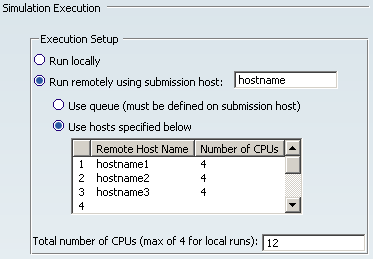General Options | ||
| ||
Simulation Execution

- Run locally
- Select this option to compute all simulations on your local machine—the same machine that is running the DesignSight workbench. All simulations can be run locally without any special configurations or licensing.
- Run remotely using submission host
- Select this option to compute all simulations on a remote machine or machines; enter the name of the submission host for the remote cluster.
Running remotely allows you to take advantage of greater computing resources than may be available on your local machine. The remote machines must be configured before you can run simulations on them. See the Abaqus Simulation Engine Installation Guide for more information.
If you are running remotely, you must select one of the following options:
- Use queue to use a predefined queue on the submission host to distribute the simulation computation.
- Use hosts specified below to distribute the simulation computation across a specified list of hosts. Complete the table of host names and the number of processors to use on each host. DesignSight utilizes the hosts in the order they are specified until it reaches the total number of CPUs requested below.
- Total # of CPUs
- Indicate the number of processors that are used to compute your simulation. For local execution a maximum of four processors can be used. For remote execution the number of processors available on the specified queue or hosts determines the maximum limit.
| Important: DesignSight frequency simulations must be computed on a single host. DesignSight will use only the first host in a queue or a host list to perform a frequency simulation. Multiple processors on the same host can be used (as determined by the Total # of CPUs setting and the number of processors available on the host). |
![]()
Simulation Stopping Criteria

Stopping criteria allow you to automatically abort a simulation based on results that are reported intermittently during a simulation. The stopping criteria are designed to prevent poorly defined or unrealistic simulations from consuming excessive system resources. Generally you should not need to modify the stopping criteria settings.
Some simulations will run to completion even though they exceed the stopping criterion. However, for long-running simulations the stopping criterion prevents the consumption of time and computing resources once an obvious failure limit has been exceeded. Diagnostic results are displayed indicating the state of the part at the point at which the simulation stopped.
- Use plastic strain (PEEQ) limit
- Select this option to stop stress simulations if a specified plastic strain has been exceeded in your model (these stopping criteria do not apply to thermal simulations). During a simulation, DesignSight checks the PEEQ values periodically to determine if the simulation should continue.
- Allowable percent plastic strain (PEEQ)
- Specify the value of plastic strain (expressed as a percentage) above which a simulation should stop running.